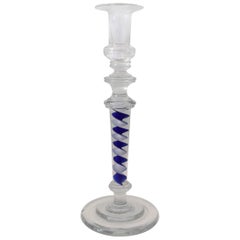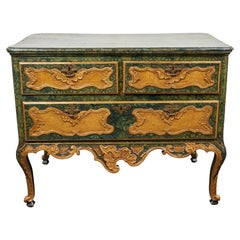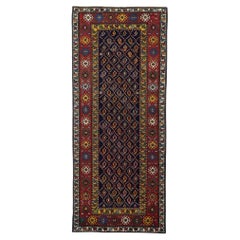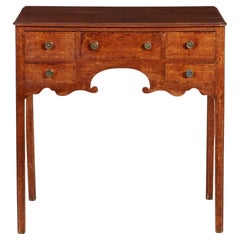USA
to
108
788
1,181
454,702
452,938
195,486
178,710
136,364
78,430
64,954
47,592
42,657
37,707
32,403
31,602
27,351
25,933
17,837
17,605
15,764
15,435
12,512
9,786
8,706
8,068
5,622
5,219
4,321
4,216
2,647
2,127
2,096
1,683
1,335
1,138
1,123
1,017
788
767
735
670
567
544
499
490
387
378
299
274
222
122
105
101
93
82
74
56
52
50
40
26
25
25
18
4
15
5
4
3
3
Period: Early 1800s
Unusual Large English Glass Candlestick, circa 1800
Located in New York, NY
This large and dramatic blown and cast-glass candlestick, with a blue-and-white spiral in its stem, was most likely made in England around 1800. It comes from the collection of the legendary aesthete Baron Max Fould-Springer, who lived at the Palais de Royaumont outside Paris, which on his death was inherited by his sister Liliane, Baroness de Rothschild...
Category
Early 1800s Great Britain (UK) George III Antique USA
Materials
Glass
Faux Marbled, Venetian Commode
Located in Los Angeles, CA
A striking, c. 1800 hand-carved, painted, and parcel gilt Venetian commode with three, sinuously paneled drawers. The whole in faux verde and Siena ma...
Category
Early 1800s Italian Antique USA
Materials
Wood
Fine Antique Shirvan Rug 3'5'' x 8'9''
Located in New York, NY
From the southern Caucasus, this good condition long piece presents a dark indigo blue field decorated with a diamond lattice enclosing row by row reversing botehs, but all in one ge...
Category
Early 1800s Caucasian Antique USA
Materials
Wool
Tall Georgian Oak Lowboy
Located in Greenwich, CT
An elegant lowboy or side table in quarter sawn oak having three plank top with molded edge and rounded corners over three drawers with longer center drawer over two lower drawers al...
Category
Early 1800s English Georgian Antique USA
Materials
Oak
George Brookshaw (1751-1823), Pear Cluster, PL XLIX
Located in Bristol, CT
Print Sz: 11 1/2"H x 9 1/2"W
Frame Sz: 19 1/4"H x 16 3/4"W
Publisher: Longman, Hurst, Rees, Orme & Brown
Plate XLIX
George Brookshaw, also known as G. Brown, was a notable Englis...
Category
Early 1800s USA
Materials
Engraving
George Brookshaw (1751-1823), Fruit Cluster, PL XII
Located in Bristol, CT
Print Sz: 11 1/2"H x 9 1/2"W
Frame Sz: 19 1/4"H x 16 3/4"W
Publisher: Longman, Hurst, Rees, Orme & Brown
Plate XII
George Brookshaw, also known as G. Brown, was a notable English...
Category
Early 1800s USA
Materials
Engraving
George Brookshaw (1751-1823), Blue Muscadine Grape, PL XXXVIII
Located in Bristol, CT
Print Sz: 11 1/2"H x 9 1/2"W
Frame Sz: 19 1/4"H x 16 3/4"W
Publisher: Longman, Hurst, Rees, Orme & Brown
Plate XXXVIII
George Brookshaw, also known as G. Brown, was a notable Eng...
Category
Early 1800s USA
Materials
Engraving
1806 Printed Linen Kerchief Glorifying George Washington, Germantown, Penn
Located in York County, PA
EXTRAORDINARILY EARLY (1806) PRINTED LINEN KERCHIEF GLORIFYING GEORGE WASHINGTON, PRINT WORKS, GERMANTOWN, PENNSYLVANIA
Printed in blue ink on coarse, white linen, this patriotic kerchief shows a standing portrait of George Washington, above which is a swag valance and the words “The Effect of Principle, Behold the Man”. The portrait is based on a mezzotint after Gilbert Stuart’s very famous painting of Washington in his later years, most often referred to as the Landsdowne portrait. Stuart painted three versions of it in oil on canvas, one of which was completed in 1796 for a wealthy merchant by the name of William Constable, who commissioned the work for Alexander Hamilton.
The kerchief is interesting because it is both American-made and documented. This is exceptionally unusual for any printed textile of the 19th century or prior and the earlier the time period the more unlikely an object is to be identified. This kerchief and a companion piece entitled “The Love of Truth Mark the Boy” (also glorifying Washington, through the fabled story of the cherry tree), were made circa 1806 by Germantown Print Works in Germantown, Pennsylvania.
To the left of Washington's image is a portion of his infamous farewell address to his troops at the end of the Revolutionary War. To the right is a short excerpt from his eulogy. Below these are three images. In the center is a square-rigged tall ship with “Commercial Union” above it, flanked by the American eagle on the left and the British lion on the right. It is reasonable to assume that the textile may have been produced in demonstration of the maker's desire, and/or that of others, to advance trade with England. Commercial printers were very influential in early America, as they possessed the means by which to disseminate information.
This kerchief and its companion piece are documented in Threads of History, Americana Recorded on Cloth, 1775 - the Present, by Herbert Ridgeway Collins (1979, Smithsonian Press), p. 63, items 38 & 39.* The two pieces pictured are in the collection of Cornell University, but the Collins text also cites an uncut pair to be present in the collection of the Western Reserve Historical Society, Cleveland, OH. The name "Germantown Print Works" is printed on the Western Reserve examples. Another example of the textile in question is documented in "Running for President, The Candidates and Their Images, 1789-1896" by Schlesinger, Israel, and Frendt, (1994, Simon & Schuster), p. 15.
I have seen three different color variations of this textile, including sepia, mulberry red, and blue. This particular example has a hand-sewn binding along the top, lower, and left edges.
Mounting: The textile was mounted and framed within our own conservation department, which is led by expert staff. We take great care in the mounting and preservation of flags and have framed thousands of examples.
The gilded molding has a rippled profile and dates to the period between 1825 and 1850.The background is 100% cotton twill, black in color. The glazing is U.V. protective plexiglass. Feel free to contact us for more details.
Condition: There is an all-over golden oxidation of the white fabric and there is very minor staining. There are tiny tack holes in each corner and there are minor nicks around the perimeter.
* Collins relates that Germantown Printworks was operated by the Hewsons. In doing so he cites one of Worthington Chauncey Ford's books on George Washington, but it isn't clear which one (there are many) and no page numbers are given. John Hewson was an Englishman who came to America and opened his printing business on the advice of Benjamin Franklin. He was one of the first “calico printers” and is the earliest documented to have advertised printed kerchiefs. His ads for bandanas appear as early as June 20th, 1774. He is suspected of having produced the very first American kerchief that pictured an American president, which is documented in Collins as item 1 on page 48. Linda Eaton, curator at Winterthur, in 2012, is currently doing in depth research on the three printers of fabrics that were operating in Germantown in early America. She discovered that the owner and/or operator of Germantown Print Works, while not currently known, was not John Hewson. This information is not yet published. She also noted that Winterthur possessed examples of the two George Washington textiles...
Category
Early 1800s American Antique USA
Materials
Cotton



